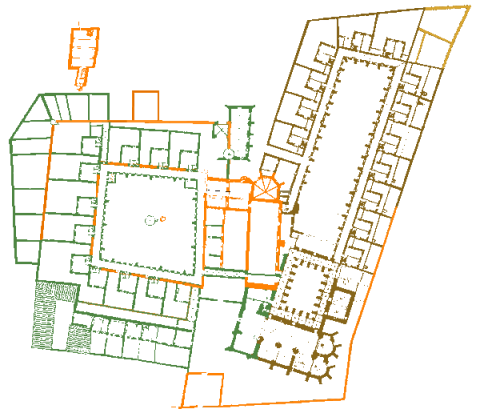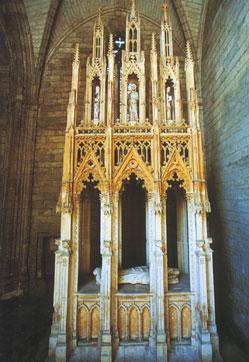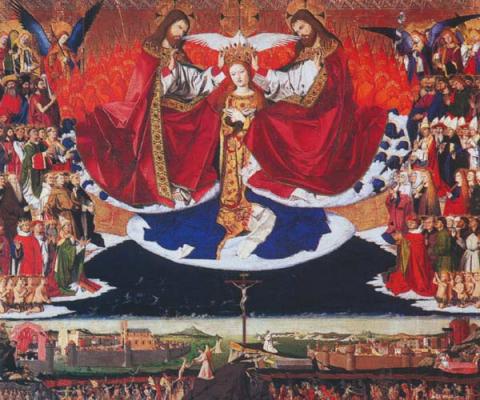THE SECOND CHARTREUSE, THE ERA OF RICH PROTECTORS
Pope Innocent VI, the founder of the monastery, died in 1362 but his nephews, who were all cardinals, continued his work throughout the next decade. In 1365, the Aubert cardinal’s palace, the first palace built by Innocent VI burned in mysterious circumstances.
Pierre de Monteruc decided to build a second Chartreuse where the palace once stood. He generously endowed this second Chartreuse and doubled the number of fathers; and became known as the second founder of La Chartreuse. Because there were now 24 monks, he had new monks’ cells built around the new Saint John’s cloister, also known as the upper cloister, built around 1372. The church also had grown too small. A new bay was added, with new chapels devoted to Saint Bruno and Saint Michael. This new building was reserved for the Brothers, while the Fathers gathered in the older building.
Pierre de Monteruc was not the only member of the Aubert clan to display such generosity. The cardinal and priest Audouin Aubert, bishop of Ostia, and cardinal-priest Estienne Aubert, bishop of Carcassone also sought to pursue Innocent VI’s work. They bequeathed significant sums of money and rebuilt part of the building which had been destroyed by the fire. The fate of La Chartreuse is clearly inextricably linked to the protection from this illustrious family. The generosity of the Aubert clan enabled the community to thrive and grow rich. Other large local families followed the Aubert’s example and left land and buildings to La Chartreuse. The monastery used the revenues from these donations to give alms to the poor and commission work from prestigious artists (1) which later hung on its walls.
In the early 17th century, the belongings owned by La Chartreuse were quite considerable. Its lands extended not only all around the monastery itself, in Avignon, the islands in the Rhône, in Pujaut, Aramon, Sorgues, they also went far afield in the Comtat Venaissin and in Pont Saint Esprit where La Chartreuse owned priories. As of 1603, Claude de Montconis, from Lyon, began work to dry the marshes in Pujaut and in Rochefort where the Chartreux fathers had fishing rights. In return, the monastery received payment in the form of lands which created an estate of 500 hectares of very good soil. Three farms were created: Saint Hugues (1616), Saint Bruno (1653), and Saint Anthelme (1681). Records show that one century later, the farms were raising 542 sheep and 213 ewes. The influence from La Chartreuse was felt far and wide. Novices came to the monastery, which also educated illustrious churchmen and scientists. La Chartreuse also provided assistance to the poor in times of famine, plague and flood.
(1) In the 15th century, the Chartreux, or rather their rich benefactors began embellishing the monastery with works commissioned from famous painters. Le Couronnement de la Vierge, by Enguerrand Quarton, is an outstanding symbol of the union of art and religion that the walls of La Chartreuse continually celebrated.
With time, the monastery was hung with sumptuous art works by Philippe de Champaigne and Nicolas Mignard among others. In 1696, the arrival of Brother Jean-Gabriel Imbert led to a veritable school of art starting inside La Chartreuse. The subjects were always of course religious, and art was at the service of spirituality. Nevertheless art shone forth here, despite the hermit-like austerity preached by Saint Bruno and the Carthusian reticence with respect to image, likely to distract the mind and spirit from pure contemplation. The Council of Trent (1545-1563), which had proclaimed that the use of images was authorized, had reconciled the different sides of this debate.





